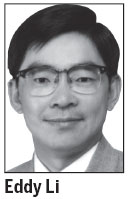Strengthen control over subdivided units
Updated: 2013-01-10 06:14
By Eddy Li(HK Edition)
|
|||||||
A commentary written by a senior manager of a property agency - "Standardizing subdivided units in industrial buildings serves multiple purposes" - has aroused my interest. With the discussion of the Panel on Housing in LegCo, the issue is worthy of further probing.
I empathize with many points mentioned in the article. In recent years, increasing cases of reconstructed industrial units appeared, even in the factory areas. These units, on one hand, bring more money to the building owners, and provide more affordable choices for low-income families on the other. The problem is, however, most of these buildings don't have complete fire service installations and equipment. Some staircases are filled with sundries; some industrial units are even divided into 46 parts. Once a fire breaks out, the consequence would just be disaster - the danger is obvious.
The article also points out the necessity of transforming factories into residential buildings, effectively to relieve the intensifying land issues. The transformation is feasible only with help from the government, including professional advice, and related legislation. The policy put forward last September - to allow eligible industrial buildings to be converted for residential use - is aiming at providing small-sized flats in a very short time to relieve the pressure of housing supply, and, at the same time, bringing the wider issue under the government's jurisdiction.

This is the reflection of the government's awareness of the severity of subdivided units in industrial buildings. These units are actually the outcome of a free market, effectively solving the housing problems for relatively poor families. Increasing such units represent the rising demand. As a result, rather than suppress them, the government should encourage the legalization of industrial subdivided units instead, under the Fire Safety (Buildings) Ordinance, of course.
At the end of article, it suggested a "tolerable fee" should be charged from the building owners by the government, to encourage them to provide such flats and effectively use the lands, and to increase government income. Actually, the policy is even more concessional than that, charging no such fees and allowing eligible owners to reconstruct without having to pay the premium.
At the meeting of the Panel on Housing on Jan 7, the government clearly admitted the value of subdivided units in factories and said that the authorities would not take comprehensive action to forbid them. Some people might be optimistic about their legalization.
From my point of view, however, the legislation won't be that easy. On top of government policy and public support, there are many ordinances to follow. According to Building (Planning) Regulations, "No part of any room used for habitation shall be more than 9 meters, measured within the room, from a prescribed window which faces directly into the external air". As for kitchens and bathrooms, windows are required. That is to say, the residential lighting requirements are stricter than those for industrial buildings.
If under the current lighting requirement, how many subdivided units are actually qualified? And what should we do if they don't? We must abide by the law. Therefore, if regulating actions are imposed on these units, most of them would not pass the censorship; even if the owners are willing to reconstruct, the requirements are too hard to reach, and the result might probably be the demolishment of more than 80 percent of them, "dishousing" lots of the inhabitants.
Nevertheless, the regulation is necessary, for these units are violating the current ordinance for the use of industrial buildings. The real difficulty lies in the execution of related laws - this is also a hard nut to crack in the first policy address by CE Leung Chun-ying.
The author is vice-president of the Chinese Manufacturers' Association of Hong Kong.
(HK Edition 01/10/2013 page3)